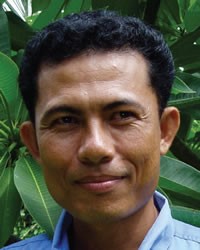Lao in Laos

Photo Source:
Cambodia Research Network
|
Send Joshua Project a map of this people group.
|
| People Name: | Lao |
| Country: | Laos |
| 10/40 Window: | Yes |
| Population: | 3,718,000 |
| World Population: | 4,114,000 |
| Primary Language: | Lao |
| Primary Religion: | Buddhism |
| Christian Adherents: | 3.50 % |
| Evangelicals: | 2.00 % |
| Scripture: | Complete Bible |
| Ministry Resources: | Yes |
| Jesus Film: | Yes |
| Audio Recordings: | Yes |
| People Cluster: | Lao |
| Affinity Bloc: | Southeast Asian Peoples |
| Progress Level: |
|
Introduction / History
Ancestors of the Lao once lived in China. Relentless pressure by the Chinese gradually forced them southward, and many settled along the Mekong River in the eighth or ninth century. The Lao language is among the Tai linguistic group, which moved with them southward from China and morphed into the language it is today. Variations of this language are spoken by the peoples we now call Lao.
What Are Their Lives Like?
Most of the Loa are wet-rice farmers. They also raise cotton, mulberry bushes (for silk worms), coco palms, and various fruits. Cultivation is done with wooden equipment drawn by buffalo. Some of the farmers are also blacksmiths, carpenters, or miners. Iron and tin are exploited, as well as some gold along the Mekong River. Certain villages specialize in crafts such as pottery, or in the production of goods such as tobacco or charcoal. A number of the Lao are also fishermen.
The Lao avoid living in the mountains, choosing instead to dwell in the plains. They live in villages alongside rivers or near roads that give them access to Chinese merchants. Their villages range in size from ten to several hundred families. Lao houses are typically made of wood or bamboo and are built high on stilts. Family livestock, which includes poultry, pigs, and goats, is allowed to run freely underneath the houses. Nearly every family raises cattle and buffaloes, in order to trade the leather and hides.
Lao social structure is based on family units, with no widespread lineages or clans. Sexual promiscuity before marriage is relatively common.
The elite Lao live in concentrated areas, which include the civil capital of Vientiane, the royal capital of Luang Praband, and a few towns along the Mekong. The Lao elite tend to lead westernized lifestyles, and manufactured clothing is gradually replacing all but the traditional woman's skirt, called a pha sin.
The Lao have a variety of folk arts, which include weaving, basket making, wood and ivory carving, and working with silver and gold. They have a variety of musical instruments, of which a bamboo wind instrument called the khene is the most widely known. Lam is a musical form common to the Lao. It combines music with poetry and storytelling. Their traditional literature has been influenced by both Hinduism and Buddhism. The Lao enjoy soccer, boat racing, Ka-taw or kick-volleyball and martial arts.
What Are Their Beliefs?
The Buddhist Wat, or temple, is the center of Lao village life. Village leadership is usually divided; the chief has authority in secular matters, while the Buddhist monk has authority in religious issues. Traditionally, young men enter village monasteries for about three months to study Buddhism. Lao Buddhists believe that right thinking, ritual sacrifices, and self-denial will enable the soul to reach nirvana (a state of eternal bliss) at death. Buddhists also believe that existence is a continuing cycle of death and rebirth, a process known as reincarnation.
Commonly the Lao combine Buddhism with faith in non-living objects called Satsana Phi. They seek help through various supernatural beings and objects. They are especially interested in the actions of territorial spirits. They live in fear of these gods and constantly strive to appease them with religious chants, rituals and sacrifices. Buddhism allows for these beliefs. Yet it shows that Buddhism has no power to protect people from wicked spirits.
What Are Their Needs?
Laos is a poor country even by the standards of their region. They need to find a good way to improve their economy.
Prayer Points
Pray for power encounters that will clearly show to the Lao people that Christ has far more power than the spirit world.
Ask the Lord to thrust out loving workers to the Buddhist Lao people.
Pray for effective strategies to reach them along with essential prayer efforts.
Ask God to use Lao believers to share the love of Jesus with their own people.